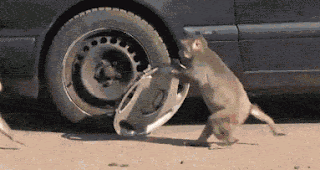Wednesday, November 30, 2016
Fractal based on Steiner chains
Steiner chains what is it?
In geometry, a Steiner chain is a set of n circles, all of which are tangent to two given non-intersecting circles, where n is finite and each circle in the chain is tangent to the previous and next circles in the chain.
Read & learn:http://mathworld.wolfram.com/SteinerChain.html
Tuesday, November 29, 2016
Gilt bronze dragon ritual bell
Cast in Bianzhong, China, dated 1743.
Bells of this type were known as bianzhong and were assembled in graduated sets of sixteen, providing twelve musical tones with the four repeated notes in lower or higher octaves.
Bianzhong were essential in ritual ceremonies at the Imperial altars, formal banquets and during processions.
Price Realized: HK$32,807,500 ($4,223,933)
Source & further reading:http://www.alaintruong.com/archives/2008/05/28/9352547.html
Memory activation before exposure reduces life-long fear of spiders - NEUROSCIENCE
Many people suffer from anxiety and fears, and a common treatment for these problems is exposure therapy. In a new study published in Current Biology, researchers at Uppsala University have shown how the effect of exposure therapy can be improved by disrupting the re-creation of memories of fear in people with arachnophobia.
Studies show that up to 30 per cent of all people suffer an anxiety disorder at some point in their lives. Anxiety leads to great suffering for those affected, but can be treated with exposure therapy, in which the patient is gradually exposed to the object or context that provokes the reactions. If exposure therapy is successful, a new ‘safe’ memory is formed, which overshadows the old fear memory. But not everyone is helped by this treatment, in part because the learning that takes place during the treatment is not permanent; the memory may return at some point later on after an initially successful exposure. Memory researchers have now demonstrated that the improvement can be made more lasting.
When a person is reminded of something, the memory becomes unstable and is re-saved. If you disrupt the re-saving of the memory, so-called reconsolidation, the creation of the memory can be disrupted and the memory that is saved can be changed. A fear memory could thus be weakened or erased, and this offers hope for improved treatment of anxiety disorders. But until now there has been doubt if this would be possible because older and stronger memories have proven to be difficult to disrupt.
In a study published in the prestigious journal Current Biology, researchers from Uppsala University and Karolinska Institutet have now for the first time shown that it is possible to use this method to reduce fear in life-long phobias. The researchers exposed individuals with arachnophobia to spider pictures while measuring their brain activity in the amygdala, a part of the brain that is strongly linked to fear.
They found that an activation of the fear memory, consisting of a mini exposure 10 minutes before a more extensive exposure, led to significantly reduced amygdala activity when the subjects looked at the spider pictures again the following day. Because the memory is made unstable before exposure and re-saved in its weakened form, the fear does not return as easily. The day after exposure, the group that received an initial activation of their spider fear showed reduced amygdala activity in comparison with a control group. Avoidance of spiders also decreased, which could be predicted from the degree of amygdala activation.
Source & further reading:http://www.uu.se/en/media/news/article/?id=7038&area=2,4,10,16,24&typ=artikel&lang=en
Paper:http://www.cell.com/current-biology/abstract/S0960-9822(16)30934-4?_returnURL=http%3A%2F%2Flinkinghub.elsevier.com%2Fretrieve%2Fpii%2FS0960982216309344%3Fshowall%3Dtrue
Corina Marinescu
Monday, November 28, 2016
How the heart turns into bone
Connective tissue cells in the heart turn into bone-producing cells in response to injury, University of California, Los Angeles scientists report November 17 in Cell Stem Cell. The discovery helps explain why some people who survive heart damage develop abnormal calcium deposits – the main component of bone – in the valves or walls of the heart. The researchers also show that heart calcification can be prevented in mice by blocking an enzyme that regulates bone mineralization with small molecules.
Paper:http://www.sciencedirect.com/science/article/pii/S1934590916303459
Source & further reading:https://www.sciencedaily.com/releases/2016/11/161117151804.htm
Image:The figure shows calcium deposits in the hearts of mice (A,D) and the effect of two drugs, ARL67156 (B,E) and etidronate (C,F), in decreasing the extent of calcium deposits after heart injury.
Credit: Pillai and Li et al./Cell Stem Cell 2016 .
Corina Marinescu
Pluto's Sputnik Planum
Is there an ocean below Sputnik Planum on Pluto? The unusually smooth 1000-km wide golden expanse, visible in the featured image from New Horizons, appears segmented into convection cells. But how was this region created? One hypothesis now holds the answer to be a great impact that stirred up an underground ocean of salt water roughly 100-kilometers thick.
The featured image of Sputnik Planum, part of the larger heart-shaped Tombaugh Regio, was taken last July and shows true details in exaggerated colors. Although the robotic New Horizons spacecraft is off on a new adventure, continued computer-modeling of this surprising surface feature on Pluto is likely to lead to more refined speculations about what lies beneath.
Image & info via APODhttp://apod.nasa.gov/apod/astropix.html
Image Credit: NASA, Johns Hopkins U./APL, Southwest Research Inst.
Subscribe to:
Posts (Atom)
































































